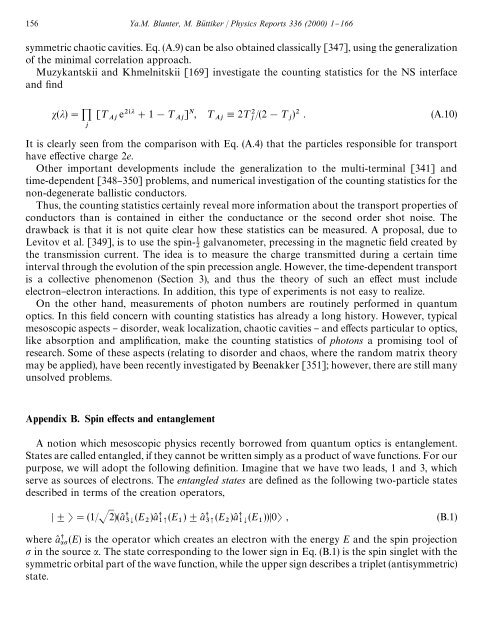shot noise in mesoscopic conductors - Low Temperature Laboratory
shot noise in mesoscopic conductors - Low Temperature Laboratory
shot noise in mesoscopic conductors - Low Temperature Laboratory
Create successful ePaper yourself
Turn your PDF publications into a flip-book with our unique Google optimized e-Paper software.
156 Ya.M. Blanter, M. Bu( ttiker / Physics Reports 336 (2000) 1}166<br />
symmetric chaotic cavities. Eq. (A.9) can be also obta<strong>in</strong>ed classically [347], us<strong>in</strong>g the generalization<br />
of the m<strong>in</strong>imal correlation approach.<br />
Muzykantskii and Khmelnitskii [169] <strong>in</strong>vestigate the count<strong>in</strong>g statistics for the NS <strong>in</strong>terface<br />
and "nd<br />
()" [¹ e#1!¹ ], ¹ ,2¹/(2!¹ ) . (A.10)<br />
<br />
<br />
It is clearly seen from the comparison with Eq. (A.4) that the particles responsible for transport<br />
have e!ective charge 2e.<br />
Other important developments <strong>in</strong>clude the generalization to the multi-term<strong>in</strong>al [341] and<br />
time-dependent [348}350] problems, and numerical <strong>in</strong>vestigation of the count<strong>in</strong>g statistics for the<br />
non-degenerate ballistic <strong>conductors</strong>.<br />
Thus, the count<strong>in</strong>g statistics certa<strong>in</strong>ly reveal more <strong>in</strong>formation about the transport properties of<br />
<strong>conductors</strong> than is conta<strong>in</strong>ed <strong>in</strong> either the conductance or the second order <strong>shot</strong> <strong>noise</strong>. The<br />
drawback is that it is not quite clear how these statistics can be measured. A proposal, due to<br />
Levitov et al. [349], is to use the sp<strong>in</strong>- galvanometer, precess<strong>in</strong>g <strong>in</strong> the magnetic "eld created by<br />
<br />
the transmission current. The idea is to measure the charge transmitted dur<strong>in</strong>g a certa<strong>in</strong> time<br />
<strong>in</strong>terval through the evolution of the sp<strong>in</strong> precession angle. However, the time-dependent transport<br />
is a collective phenomenon (Section 3), and thus the theory of such an e!ect must <strong>in</strong>clude<br />
electron}electron <strong>in</strong>teractions. In addition, this type of experiments is not easy to realize.<br />
On the other hand, measurements of photon numbers are rout<strong>in</strong>ely performed <strong>in</strong> quantum<br />
optics. In this "eld concern with count<strong>in</strong>g statistics has already a long history. However, typical<br />
<strong>mesoscopic</strong> aspects } disorder, weak localization, chaotic cavities } and e!ects particular to optics,<br />
like absorption and ampli"cation, make the count<strong>in</strong>g statistics of photons a promis<strong>in</strong>g tool of<br />
research. Some of these aspects (relat<strong>in</strong>g to disorder and chaos, where the random matrix theory<br />
may be applied), have been recently <strong>in</strong>vestigated by Beenakker [351]; however, there are still many<br />
unsolved problems.<br />
Appendix B. Sp<strong>in</strong> e4ects and entanglement<br />
A notion which <strong>mesoscopic</strong> physics recently borrowed from quantum optics is entanglement.<br />
States are called entangled, if they cannot be written simply as a product of wave functions. For our<br />
purpose, we will adopt the follow<strong>in</strong>g de"nition. Imag<strong>in</strong>e that we have two leads, 1 and 3, which<br />
serve as sources of electrons. The entangled states are de"ned as the follow<strong>in</strong>g two-particle states<br />
described <strong>in</strong> terms of the creation operators,<br />
$"(1/2)(a( s (E )a( t (E )$a( t (E )a( s (E ))0 , (B.1)<br />
where a( (E) is the operator which creates an electron with the energy E and the sp<strong>in</strong> projection<br />
<strong>in</strong> the source . The state correspond<strong>in</strong>g to the lower sign <strong>in</strong> Eq. (B.1) is the sp<strong>in</strong> s<strong>in</strong>glet with the<br />
symmetric orbital part of the wave function, while the upper sign describes a triplet (antisymmetric)<br />
state.
















